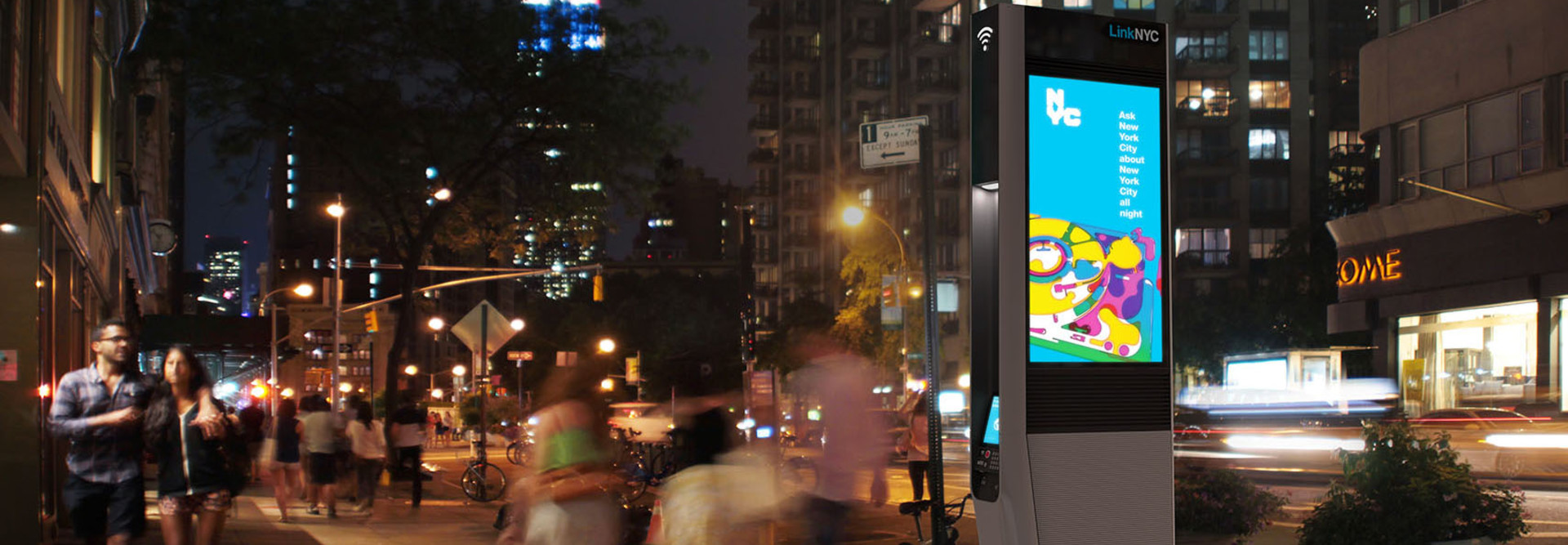New York Launches First ‘Links’ in Old Phone Booths with Gigabit Wi-Fi
New York City has begun rolling out its LinkNYC kiosks in Manhattan, converting old phone booths into new hubs promising gigabit Wi-Fi Internet speeds and mobile applications via Android tablets. Although the program is starting with a stretch along Third Avenue in Manhattan, New York City Mayor Bill de Blasio has vowed to bring the kiosks, dubbed Links, to neighborhoods in all five of the city’s boroughs.
CityBridge, the consortium of companies that are building and managing the Links, was selected in November 2014. Now there are 17 active Links in Manhattan, but, according to a statement from the mayor’s office, there will be 500-plus kiosks operational by the end of July and more than 4,500 by mid-2019. The rollout of the program will take years to complete.
“LinkNYC is the Wi-Fi network New Yorkers deserve: the largest, fastest municipal Wi-Fi network in the world – and you won’t need to insert a quarter in the slot, because it’s completely free,” de Blasio said. “LinkNYC brings us a couple steps closer to our goal of leveling the playing field and providing every New Yorker with access to the most important tool of the 21st century.”
Building a Superfast Wi-Fi Network
According to the mayor’s administration, Links will be activated after high-speed fiber optic cables are installed in different sections of the city. Each Link can broadcast a Wi-Fi hotspot with a range of around 150 feet.
The kiosks will offer free domestic calling, two USB charging ports, an Android tablet with Internet access, and a 911 button to contact emergency services.
CityBridge consists of Intersection, Qualcomm and CIVIQ Smartscapes. As Motherboard notes, Intersection is partly owned by Sidewalk Labs, which is a subsidiary of Alphabet, the parent company of Google.
The city’s franchise agreement with CityBridge states that each link “must be capable of supporting up to 256 devices with a total aggregate throughput of 1Gbps,” Motherboard reports. The online publication explains the downside of this good news: If there are hundreds of users connecting to one link, real throughput speeds will likely be much slower. Conducting its own test the day the network was launched, Motherboard discovered that the downlink speeds were 70 megabits per second at one Link, and 230 Mbps at another one block away.
As The Verge notes, after you sign in to the LinkNYC Wi-Fi network on your first kiosk visit and save it to your device, you will not need to do so again when connecting to other Links.
To assure a wary public that is used to data being compromised, New York City is highlighting the system’s cybersecurity measures.
“LinkNYC will offer an encrypted network for HotSpot 2.0-enabled devices, making it the first encrypted public Wi-Fi network of this scale to add a critical layer of protection to personal data,” the mayor’s office said in the media announcement. “The de Blasio administration and CityBridge have also created a customer-first privacy policy that ensures personal information is never shared or sold for third-party use.”
However, there are privacy concerns with the new setup, as Motherboard reports: “This concern is especially acute because Links will include location-based services using so-called ‘beacon’ technology, which sends out geo-targeted Bluetooth-based signals to users who choose to receive them, according to the project’s website. What’s more, Links ‘will collect anonymized and aggregate data to develop insights on usage and system diagnostics to improve your Link experience and to deliver more relevant advertising,’ according to CityBridge.”
Using Android Tablets
According to The Verge, the tablets in the kiosks have been custom built by Intersection, and as PC Magazine notes, they use Qualcomm’s processors. Users can make Voice over IP calls via Vonage. The kiosks feature headphone jacks, allowing visitors to make phone calls with more privacy, and USB ports to charge cellphones.
The tablets in the kiosks let users access city services via New York’s web-based 311 app and get directions via Google Maps. Colin O'Donnell, chief technology officer of Intersection, told The Verge that the tablets can withstand extreme temperatures (-4°F to 104°F) and that the kiosks were tested to ensure they can survive even car crashes. O’Donnell said the tablets in the kiosks could be used to let residents vote on how to allocate small sums of city money and to highlight local events or issues. "We're looking into how we can surface that information," he said.
The city plans to add apps, features and services to the tablets over time, according to TechCrunch.









